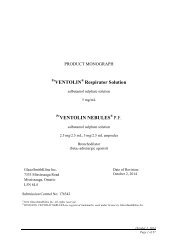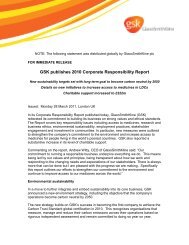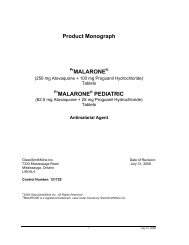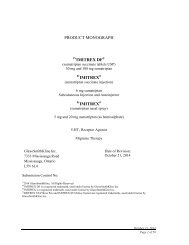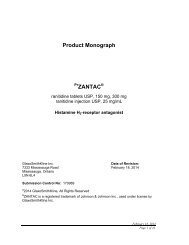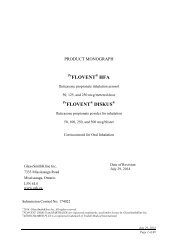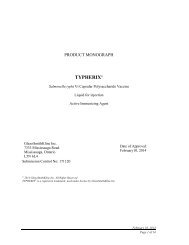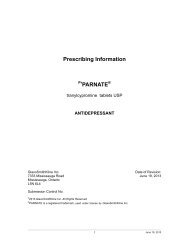ADVAIR DISKUS ADVAIR - GlaxoSmithKline
ADVAIR DISKUS ADVAIR - GlaxoSmithKline
ADVAIR DISKUS ADVAIR - GlaxoSmithKline
You also want an ePaper? Increase the reach of your titles
YUMPU automatically turns print PDFs into web optimized ePapers that Google loves.
Pharmacodynamics<br />
The pharmacodynamic effects and pharmacokinetics of the combination product in the<br />
<strong>DISKUS</strong> ® powder inhaler were investigated in healthy adult male and female volunteers<br />
after single and repeat-dose administration.<br />
Those studies showed that the systemic pharmacodynamic effects of salmeterol xinafoate<br />
and fluticasone propionate are essentially unchanged when the two drugs are<br />
administered in combination, when compared with the component drugs given alone or<br />
concurrently.<br />
There was no evidence that the systemic exposure to salmeterol was altered by<br />
concomitant exposure to fluticasone propionate. In one study, the salmeterol plasma C max<br />
and T max were not significantly different when compared between the groups receiving<br />
salmeterol xinafoate 100 mcg and fluticasone propionate 500 mcg twice daily in the<br />
combination product (C max 0.23 ng/mL) or salmeterol xinafoate 100 mcg twice daily as a<br />
single agent (C max 0.22 ng/mL).<br />
When fluticasone propionate alone or the salmeterol xinafoate/fluticasone propionate<br />
product are administered at the same dosage, there is similar systemic exposure to<br />
fluticasone propionate.<br />
Pharmacokinetics<br />
There is no evidence in animal or human subjects that the administration of salmeterol<br />
xinafoate and fluticasone propionate together by the inhaled route affects the<br />
pharmacokinetics of either component. For pharmacokinetic purposes therefore each<br />
component can be considered separately.<br />
Salmeterol Xinafoate<br />
Salmeterol acts locally in the lung; therefore, plasma levels are not an indication of<br />
therapeutic effect. Because of the low therapeutic dose, systemic levels of salmeterol are<br />
low or undetectable after inhalation of recommended doses (50 mcg twice daily).<br />
Salmeterol is predominantly cleared by hepatic metabolism; liver function impairment<br />
may lead to accumulation of salmeterol in plasma. Therefore, patients with hepatic<br />
disease should be closely monitored.<br />
An in vitro study showed that salmeterol is extensively metabolised to α-<br />
hydroxysalmeterol (aliphatic oxidation) by cytochrome P450 3A4 (CYP3A4). A repeat<br />
dose study with salmeterol and erythromycin in healthy volunteers showed no clinically<br />
significant changes in pharmacodynamic effects at 500 mg three times daily doses of<br />
erythromycin. However, a salmeterol-ketoconazole interaction study resulted in a<br />
significant increase in plasma salmeterol exposure (see WARNING AND<br />
PRECAUTIONS, and DRUG INTERACTIONS).<br />
In a placebo-controlled, crossover drug interaction study in 15 healthy subjects, coadministration<br />
of salmeterol (50 mcg twice daily inhaled) and the cytochrome P450 3A4<br />
(CYP3A4) inhibitor, ketoconazole (400 mg once daily orally), for 7 days, resulted in a<br />
July 29, 2014<br />
Page 30 of 67



